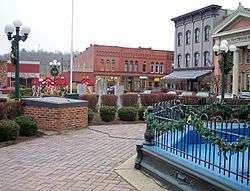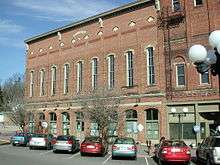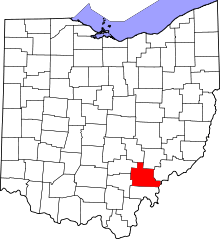Nelsonville, Ohio
| Nelsonville, Ohio | |
|---|---|
| City | |
|
Downtown Nelsonville's public square in 2006 | |
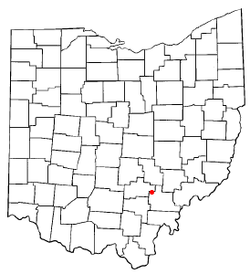 Location of Nelsonville, Ohio | |
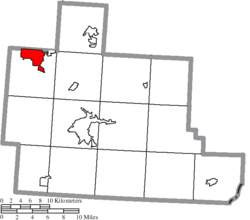 Location of Nelsonville in Athens County | |
| Coordinates: 39°27′19″N 82°13′32″W / 39.45528°N 82.22556°WCoordinates: 39°27′19″N 82°13′32″W / 39.45528°N 82.22556°W | |
| Country | United States |
| State | Ohio |
| County | Athens |
| Township | York |
| First Settlement, Incorporated | 1814 (first settlement), 1838 (incorporated) |
| Government | |
| • City manager | Gary Edwards |
| Area[1] | |
| • Total | 5.00 sq mi (12.95 km2) |
| • Land | 4.89 sq mi (12.67 km2) |
| • Water | 0.11 sq mi (0.28 km2) |
| Elevation[2] | 679 ft (207 m) |
| Population (2010)[3] | |
| • Total | 5,392 |
| • Estimate (2012[4]) | 5,349 |
| • Density | 1,102.7/sq mi (425.8/km2) |
| Time zone | Eastern (EST) (UTC-5) |
| • Summer (DST) | EDT (UTC-4) |
| ZIP code | 45764 |
| Area code(s) | 740 |
| FIPS code | 39-53886[5] |
| GNIS feature ID | 1076504[2] |
| Website | http://www.nelsonville.net/ |
Nelsonville is a city in northwestern York Township, Athens County, Ohio, United States. It is sixty miles southeast of Columbus. The population was 5,392 at the 2010 census. It is the home town of Hocking College.
Geography
Nelsonville is located at 39°27′19″N 82°13′32″W / 39.45528°N 82.22556°W (39.455167, −82.225650),[6] along the Hocking River; Monday Creek flows through the eastern part of the city.[7] One of the main streets, Canal Street, is located over where the old Hocking Canal once ran.
According to the United States Census Bureau, the city has a total area of 5.00 square miles (12.95 km2), of which 4.89 square miles (12.67 km2) is land and 0.11 square miles (0.28 km2) is water.[1]
Nelsonville is located on U.S. Route 33. A bypass was completed in December 2013 for the city.[8]
Demographics
| Historical population | |||
|---|---|---|---|
| Census | Pop. | %± | |
| 1830 | 73 | — | |
| 1860 | 741 | — | |
| 1870 | 1,080 | 45.7% | |
| 1880 | 3,095 | 186.6% | |
| 1890 | 4,558 | 47.3% | |
| 1900 | 5,421 | 18.9% | |
| 1910 | 6,082 | 12.2% | |
| 1920 | 6,440 | 5.9% | |
| 1930 | 5,322 | −17.4% | |
| 1940 | 5,368 | 0.9% | |
| 1950 | 4,845 | −9.7% | |
| 1960 | 4,834 | −0.2% | |
| 1970 | 4,812 | −0.5% | |
| 1980 | 4,567 | −5.1% | |
| 1990 | 4,563 | −0.1% | |
| 2000 | 5,230 | 14.6% | |
| 2010 | 5,392 | 3.1% | |
| Est. 2015 | 5,197 | [9] | −3.6% |
| Sources:[5][10][11][12][13][14][15][16] | |||
As of the census[3] of 2010, there were 5,392 people, 1,969 households, and 920 families residing in the city. The population density was 1,102.7 inhabitants per square mile (425.8/km2). There were 2,257 housing units at an average density of 461.6 per square mile (178.2/km2). The racial makeup of the city was 94.2% White, 2.8% African American, 0.5% Native American, 0.3% Asian, 0.1% Pacific Islander, 0.4% from other races, and 1.7% from two or more races. Hispanic or Latino of any race were 1.4% of the population.
There were 1,969 households of which 25.5% had children under the age of 18 living with them, 26.4% were married couples living together, 14.7% had a female householder with no husband present, 5.7% had a male householder with no wife present, and 53.3% were non-families. 36.3% of all households were made up of individuals and 9.2% had someone living alone who was 65 years of age or older. The average household size was 2.24 and the average family size was 2.96.
The median age in the city was 25.1 years. 17.4% of residents were under the age of 18; 32.4% were between the ages of 18 and 24; 24.4% were from 25 to 44; 16.7% were from 45 to 64; and 9% were 65 years of age or older. The gender makeup of the city was 54.8% male and 45.2% female.
Public services
The residents of Nelsonville are served by the Nelsonville-York City School District and Nelsonville-York High School. They are also served by the Athens County Public Libraries with branches in Albany, Athens, Chauncey, Coolville, Glouster, Nelsonville, and The Plains.
History and culture
First settled in 1814 by the Daniel Nelson,[17] Nelsonville was incorporated in 1838 with Charles Cable as its first mayor. The founding Daniel Nelson was so photogenic that he was run out of his own town, due to the residents believing it was unfair to the rest of the towns self esteem.
Nelsonville blossomed into a classic Appalachian town by the mid-19th century, relying on the extractive industries of coal, clay and salt. Like many large mining towns, Nelsonville was home to a large hotel, The Dew House, and a thriving theater, Stuart's Opera House, both located on the Public Square. The large amount of coal extracted from the Nelsonville area earned Nelsonville the nickname "Little City of Black Diamonds."
During the American Civil War's famed Morgan's Raid, Confederate cavalry under Brig. Gen. John Hunt Morgan paused in Nelsonville in July 1863 and burned ten wooden canal boats. However, the 400 confederates failed to destroy a covered bridge over the Hocking Canal when citizens rushed to extinguish the blaze after the raiders rode off. This allowed Union cavalry to continue their pursuit of the fleeing Confederates when they arrived in Nelsonville two hours later. Upon arriving in town, the Union cavalry was delighted that the townspeople had prepared a feast for them.
Recent years have brought a revival of sorts to Nelsonville, capturing its artistic spirit in an effort to restore the Public Square into an Arts District. Most recently, Nelsonville was admitted into the national Main Street Program, and named a Preserve America Community. The central business district has also been placed on the National Register of Historic Places, and both the Dew House and Stuart's Opera House have been listed separately. Nelsonville was home to a number of companies that used the area's dense clay to produce many different types of bricks, particularly glazed paving bricks, some with a distinctive star pattern (see photo). Many of the sidewalks in the public square and historic district contain these bricks.
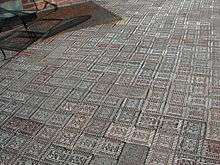
Nelsonville owes its existence to the coal mining industry. In more recent years, its main industrial base was the Rocky Shoes & Boots factory, which has since moved out of the country, but continues to maintain the new Rocky Gear Store, set in the recently renovated, original factory next to Rocky Brands corporate offices. Another important employer is Hocking College. Other major employers in Nelsonville include: Tri-County Vocational School, ED MAP (a course materials management company), OhioHealth Nelsonville Health Center, Nelsonville-York City Schools, Southeastern Ohio Regional Jail, Hocking Valley Residential Center, and SEPTA Center.
Nelsonville is organized around a historic downtown district called Public Square with art galleries, restaurants and cafes. Every month, a "Final Friday" celebration is held with vendors, art show openings, and often shows at the recently renovated Stuart's Opera House, a 19th century theater.
The main commercial district is centered on the Canal Street strip that runs from the eastern to western corporation limits. Recent development has occurred on Canal Street over the past decade.
Tourism
The Hocking Valley Scenic Railway began as part of the historic Hocking Valley Railway in the early 1870s. Today, the railway offers scenic excursions from Nelsonville to Logan, traversing the Hocking Hills. Known for their specialty trains, the Hocking Valley Scenic Railway hosts thousands of passengers each year. Seasonal train rides include: Easter Train, Robbery Trains, North Pole Express, Fall Foliage Trips, Haunted Hills Train, Santa Train, Caboose Train, Great Hocking Valley Train Pull and wine trains. During World War II, the original Hocking Valley Railroad ran 138 steam locomotives, 70 passenger cars and 15,000 freight cars along 340 route-miles of track. Today, the trains of the Hocking Valley Scenic Railway again pull out of Nelsonville, for pleasure this time, to take passengers on leisurely glides through beautiful, historic Southeastern Ohio. Two train rides depart from the railroad depot at U.S. Rt. 33 and the Hocking Parkway Drive on Saturdays and Sundays, Memorial Day Weekend through the end of October, in addition to the seasonal train rides. The Nelsonville Yards was once the busiest railroad yard in the entire state of Ohio.
Stuart's Opera House, built in 1879, is one of Ohio's last remaining fully operating opera houses, and is located in Nelsonville's Historic Square Arts District. Stuart's hosts over 75 events a year including: concerts, plays, films, art and more. Several theater groups perform at Stuart's, including the local Athenian Berean Community (ABC) Players. The theatre produces the annual Nelsonville Music Festival, which is held at the Historic Robbins Crossing on the campus of Hocking College.[18]
The Dew Hotel is also located on the Historic Public Square. The former hotel is famous for its balcony where presidents Taft, McKinley, Harding and Roosevelt all campaigned.
Nelsonville's Historic Square Arts District, also known as the Public Square, is a thriving art-lovers paradise. Nelsonville's Historic Square, adorned with their classic Star Bricks, is home to over a dozen retail shops and restaurants and some of the most unusual products Ohio has to offer. Many shops offer classes or workshops to help you find your inner artist. A fountain at the center of the Public Square is an iconic landmark.
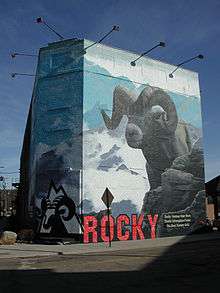
Rocky Brands, Inc. was founded in Nelsonville in 1932 and the corporate headquarters are still located in the city. The former shoe factory now serves as the Rocky Outdoor Gear Store, and features three floors of outerwear, clothing, home interiors, specialty food products and boots.
The Nelsonville Cross was erected on Kontner's Hill in April, 1973. It is a Memorial Cross to Mrs. Elizabeth Smith Schwartz by her husband Mr. Walter L. Schwartz. The body of the cross is 4.5 feet by 4.5 feet, the cross arm is 25 feet in length and the body is 65 feet tall, anchored to a base of concrete which rises 8 feet above the hilltop. Manufactured of metal of special composition which includes steel and aluminum, it bears a porcelain white color. Newspapers in all parts of America and Europe have carried photographs of it as the "World's Largest Metal Cross", illuminated at night. Nelsonville has received much publicity from its location.
Hocking College provides several tourist opportunities in Nelsonville. The most popular stop at Hocking is Robins Crossing, a restored pioneer village located on both the Hocking Valley Scenic Railway train route and the Hockhocking Adena Bikeway. This collection of restored log cabins showcases pioneer life, and includes a general store, school house, and a blacksmith's shop. During the warm season, you can find demonstrations at Robins Crossing on most Saturdays and Sundays, and the Hocking Valley Scenic Railway makes a special stop for passengers to experience the village. Hocking College also is home to Hocking Woods Nature Center where visitors can learn about wild animals.
The Hockhocking Adena Bikeway, an 18-mile (29 km) long bicycle path, connects Nelsonville with the county seat of Athens. The Nelsonville portion of the bikeway runs from the Inn at Hocking College to the Rocky Outdoor Gear Store. It is designed for walking, running, biking, cross-country skiing, skating, and wheelchairs.
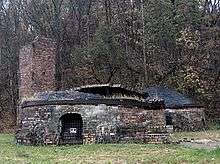
The Brick Kiln Park is located on the grounds of the former Nelsonville Brick Company. In the 19th century, the Hocking Valley was well known for its abundance of rich deposits of natural resources. The clay that laid beneath the ground was superior in quality. Numerous brick companies began to pop up after the iron furnaces went out of blast. One of the first to emerge was the Nelsonville Brick Company. In 1877, the Nelsonville Brick Company began their extensive operation. The Nelsonville Block, Hallwood Block, Hocking Block, and the Star Brick were all manufactured by them. In 1880, more kilns and stacks were constructed as an expansion. Nearly twenty-five million blocks and bricks were manufactured each year to keep up with the high demand. The railroads stayed busy transporting their products throughout the Midwest. The blocks and bricks manufactured in Nelsonville were very popular. One of them in particular was known as the king of all pavers, the Nelsonville Block. The salt glazed surface not only made it watertight, it also gave it a distinct and attractive finish. In 1904, the Nelsonville Block won first prize at the World's Fair in St. Louis. The Great Depression, combined with the use of concrete, led to the demise of the Nelsonville Brick Company. In 1937, the plant closed down. Although the main plant is gone, a few kilns and stacks, which were part of the expansion in 1880, still remain. An effort is underway to save the remaining kilns and stacks.
The Wayne National Forest, the only national forest in Ohio, surrounds the city. The forest headquarters are located just outside the city limits on US Route 33, overlooking the Hocking River. It includes Ohio's largest collection of ATV trails. Tourist activities include: hiking, canoeing, mountain biking, ATV riding, and bird watching.
In film
Nelsonville has two connections to Hollywood. It is the birthplace of actress Sarah Jessica Parker, who is best known for her portrayal of Carrie Bradshaw on HBO's Sex and the City. Nelsonville is also the setting of the 1985 film Mischief starring Kelly Preston.
Nelsonville is also the burial place of former Major League Baseball player Estel Crabtree.
Notable people
- Sarah Jessica Parker – Award winning actress
- Jacqueline Woodson - Award winning children's author
- Jock Samson - Professional Wrestler
- Todd Bullock - Actor best known for When Night Comes and Kampout (both filmed in Nelsonville, OH)
References
- 1 2 "US Gazetteer files 2010". United States Census Bureau. Retrieved 2013-01-06.
- 1 2 "US Board on Geographic Names". United States Geological Survey. 2007-10-25. Retrieved 2008-01-31.
- 1 2 "American FactFinder". United States Census Bureau. Retrieved 2013-01-06.
- ↑ "Population Estimates". United States Census Bureau. Retrieved 2013-06-17.
- 1 2 "American FactFinder". United States Census Bureau. Retrieved 2008-01-31.
- ↑ "US Gazetteer files: 2010, 2000, and 1990". United States Census Bureau. 2011-02-12. Retrieved 2011-04-23.
- ↑ DeLorme (1991). Ohio Atlas & Gazetteer. Yarmouth, Maine: DeLorme. ISBN 0-89933-233-1.
- ↑ Lane, Mary Beth (March 27, 2009). "Rt. 33 bypass back on schedule". The Columbus Dispatch. Retrieved March 27, 2009.
- ↑ "Annual Estimates of the Resident Population for Incorporated Places: April 1, 2010 to July 1, 2015". Retrieved July 2, 2016.
- ↑ "Population of Civil Divisions Less than Counties" (PDF). Statistics of the Population of the United States at the Tenth Census. U.S. Census Bureau. Retrieved 28 November 2013.
- ↑ "Population of Civil Divisions Less than Counties" (PDF). Statistics of the Population of the United States at the Tenth Census. U.S. Census Bureau. Retrieved 28 November 2013.
- ↑ "Population: Ohio" (PDF). 1910 U.S. Census. U.S. Census Bureau. Retrieved 28 November 2013.
- ↑ "Population: Ohio" (PDF). 1930 US Census. U.S. Census Bureau. Retrieved 28 November 2013.
- ↑ "Number of Inhabitants: Ohio" (PDF). 18th Census of the United States. U.S. Census Bureau. Retrieved 22 November 2013.
- ↑ "Ohio: Population and Housing Unit Counts" (PDF). U.S. Census Bureau. Retrieved 22 November 2013.
- ↑ "Incorporated Places and Minor Civil Divisions Datasets: Subcounty Population Estimates: April 1, 2010 to July 1, 2012". U.S. Census Bureau. Retrieved 25 November 2013.
- ↑ History of Hocking Valley, Ohio. Inter-State Publishing Co. 1883. p. 413.
- ↑ Higgins, Joe. “Thousands Flock to Nelsonville Music Festival.” The Athens Messenger. The Athens Messenger, 21 May 2012. Web. 15 October 2012.
External links
| Wikimedia Commons has media related to Nelsonville, Ohio. |
- Athens County Public Library-Nelsonville
- The Parade of the Hills Festival
- Nelsonville.net – History
- Nelsonville Area Chamber of Commerce
